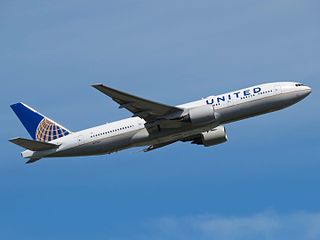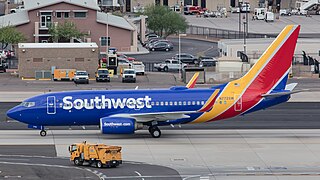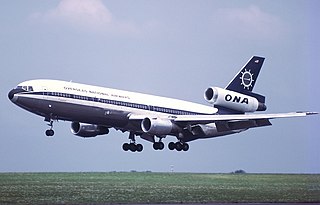
United Airlines Flight 232 was a regularly scheduled United Airlines flight from Stapleton International Airport in Denver to O'Hare International Airport in Chicago, continuing to Philadelphia International Airport. On July 19, 1989, the DC-10 serving the flight crash-landed at Sioux Gateway Airport in Sioux City, Iowa, after suffering a catastrophic failure of its tail-mounted engine due to an unnoticed manufacturing defect in the engine's fan disk, which resulted in the loss of many flight controls. Of the 296 passengers and crew on board, 112 died during the accident, while 184 people survived. 13 of the passengers were uninjured. It was the deadliest single-aircraft accident in the history of United Airlines.

The Pratt & Whitney PW4000 is a family of dual-spool, axial-flow, high-bypass turbofan aircraft engines produced by Pratt & Whitney as the successor to the JT9D. It was first run in April 1984, was FAA certified in July 1986, and was introduced in June 1987. With thrust ranging from 50,000 to 99,040 lbf, it is used on many wide-body aircraft.

The General Electric GE90 is a family of high-bypass turbofan aircraft engines built by GE Aerospace for the Boeing 777, with thrust ratings from 81,000 to 115,000 pounds-force. It entered service with British Airways in November 1995. It is one of three options for the 777-200, -200ER, and -300 versions, and the exclusive engine of the -200LR, -300ER, and 777F. It was the largest jet engine, until being surpassed in January 2020 by its successor, the 110,000 lbf (490 kN) GE9X, which has a 6-inch (15 cm) larger diameter fan. However, the GE90-115B, the most recent variant, is rated for a higher thrust than the GE9X.
New York Airways was an American helicopter airline in the New York City area, founded in 1949 as a mail and cargo carrier. On 9 July 1953 it may have been the first scheduled helicopter airline to carry passengers in the United States, with headquarters at LaGuardia Airport. Although primarily a helicopter airline operator with scheduled passenger operations, New York Airways also flew fixed wing aircraft, such as the de Havilland Canada DHC-6 Twin Otter 19-passenger STOL twin turboprop aircraft.

National Airlines Flight 27 was a scheduled passenger flight between Miami, Florida, and San Francisco, California, with intermediate stops at New Orleans, Louisiana; Houston, Texas; and Las Vegas, Nevada, United States.

Blade off testing or blade out testing is a specific form of air safety testing required by the Federal Aviation Administration and other safety agencies to certify safety performance of jet engines. The tests require engine manufacturers to carry out at least two tests of the engine, to make sure that the engine can survive a compressor or fan blade breaking off within the engine and a turbine blade breaking off within the engine, without fragments being thrown through the outside enclosure of the engine, creating a contained engine failure.

Qantas Flight 32 was a regularly scheduled passenger flight from London to Sydney via Singapore. On 4 November 2010, the aircraft operating the route, an Airbus A380, suffered an uncontained failure in one of its four Rolls-Royce Trent 900 engines. The failure occurred over the Riau Islands, Indonesia, four minutes after takeoff from Singapore Changi Airport. After holding for almost two hours to assess the situation, the aircraft made a successful emergency landing at Changi. No injuries occurred to the passengers, crew, or people on the ground, despite debris from the aircraft falling onto houses in Batam.

Indian Airlines Flight 171 was a Caravelle that crashed while attempting an emergency landing at Bombay Airport on 12 October 1976 after suffering an uncontained engine failure, killing all 95 people on board. Metal fatigue in the No. 2 engine's 10th stage high-pressure compressor disk had caused it to disintegrate, the resulting fragments severed fuel lines causing fuel to leak into the engine and ignite causing an uncontrolled fire that eventually affected control surfaces leading to a loss of control.

Delta Air Lines Flight 1288 was a regularly scheduled flight from Pensacola, Florida to Atlanta, Georgia. On July 6, 1996, the aircraft serving the flight, a McDonnell Douglas MD-88, was on takeoff roll from Runway 17 at Pensacola when it experienced an uncontained, catastrophic turbine engine failure that caused debris from the front compressor hub of the left engine to penetrate the left aft fuselage. The cause of the engine failure was found to have been a fault in the manufacture of the fan. The failure of the airline to spot the resulting crack in the blade was a contributing factor.

British Airways Flight 2276 was a scheduled international passenger service from Las Vegas to London. On 8 September 2015, the Boeing 777-200ER operating the flight suffered an uncontained engine failure and fire in the left (#1) GE90 engine during take-off from Las Vegas-McCarran International Airport, prompting an aborted take-off and the evacuation of all passengers and crew. All 170 people on board survived, but 20 were injured.

On 27 May 2016, a Boeing 777-300 of Korean Air, operating as Korean Air Flight 2708 from Haneda Airport in Tokyo to Seoul's Gimpo International Airport, was accelerating for take off when its left engine suffered an uncontained failure and a substantial fire ensued. The crew aborted the take-off, and after the aircraft came to a stop the fire was extinguished by the airport emergency services. All 319 passengers and crew were evacuated; 12 occupants were injured. The accident was attributed to poor maintenance standards and failure of the crew to carry out the emergency procedures correctly.

American Airlines Flight 383 was a scheduled passenger flight from O'Hare International Airport in Chicago, Illinois to Miami International Airport. On October 28, 2016, the Boeing 767-300ER operating the flight suffered an engine fire during takeoff. The crew aborted their takeoff, evacuating everyone on board, of whom 21 were injured. The plane was a write-off.

Centurion Air Cargo Flight 164 was a chartered international cargo flight, flying from Bogota's El Dorado International Airport while en route to Miami International Airport. The flight was operated by Kalitta Air and the aircraft was wet leased by Centurion Air Cargo. On 7 July 2008, the aircraft, a Boeing 747-209BSF registered as N714CK, crashed shortly after takeoff. All aboard suffered injuries, but none were killed. Two people on the ground were killed after the plane slammed into a farm. The crash was the second crash of a Boeing 747 in 2008 in Kalitta Air service, after a previous accident at Brussels in May.

Southwest Airlines Flight 3472 was a regularly scheduled passenger flight operating from New Orleans International Airport in New Orleans, Louisiana to Orlando International Airport in Orlando, Florida. On August 27, 2016, the Boeing 737-7H4, with 99 passengers and five crew, 12 minutes after departure from New Orleans, was climbing through 31,000 feet and heading east over the Gulf of Mexico when the aircraft's number one CFM International CFM56-7 engine suffered an engine failure. A fan blade in the engine broke due to a fatigue crack. The separated portion of the blade rotated within the engine, moving forward, striking the engine inlet. Debris from the damaged engine inlet punctured the left side of the fuselage causing a loss of cabin pressure and damaged the wing and empennage. Oxygen masks were deployed to passengers while the crew initiated an emergency descent to 10,000 feet. The aircraft then diverted to Pensacola International Airport for a safe landing about 20 minutes later without further incident. While the aircraft sustained substantial damage, there were no injuries.

Aeroflot Flight A-13 was a scheduled Soviet domestic passenger flight from Baku, Azerbaijan to Fort-Shevchenko in Kazakhstan that crashed on 18 August 1973 shortly after takeoff killing 56 of the 64 passengers and crew aboard. The Antonov An-24 had suffered an engine failure on takeoff and was attempting to return to the airport when it struck an oil rig cable at low altitude resulting in a crash. At the time, it was the second deadliest accident involving the An-24 and remains the second deadliest aviation accident in Azerbaijani history. The engine failure had been caused by the effect of continuous overheating on the performance of the blades.

On 27 April 1974, an Aeroflot Il-18 airliner crashed while operating a charter flight from Leningrad to Zaporizhzhia, continuing to Krasnodar, Russia. The plane crashed shortly after takeoff from Pulkovo Airport in Leningrad. None of the 109 people on board survived. The engine fire was caused by the uncontained failure of a faulty compressor disk.

On February 13, 2018, around noon local time, a Boeing 777-222 airplane, operating as United Airlines Flight 1175 (UA1175), experienced an in-flight separation of a fan blade in the No. 2 (right) engine while over the Pacific Ocean en route from San Francisco International Airport (SFO) to the Daniel K. Inouye International Airport (HNL), Honolulu, Hawaii. During level cruise flight shortly before beginning a descent from flight level 360, and about 120 miles from HNL, the flight crew heard a loud bang, followed by a violent shaking of the airplane, followed by warnings of a compressor stall. The flight crew shut down the failed engine, declared an emergency, and began a drift-down descent, proceeding direct to HNL where they made a single-engine landing without further incident at 12:37 local time. There were no reported injuries to the 374 passengers and crew on board and the airplane damage was classified as minor under National Transportation Safety Board (NTSB) criteria.

Southwest Airlines Flight 1380 was a Boeing 737-700 that experienced a contained engine failure in the left CFM International CFM56 engine after departing from New York–LaGuardia Airport en route to Dallas Love Field on April 17, 2018. The engine cowl was broken in the failure, and cowl fragments damaged the fuselage, shattering a cabin window and causing explosive depressurization of the aircraft. Other fragments caused damage to the wing. The crew carried out an emergency descent and diverted to Philadelphia International Airport. One passenger was partially ejected from the aircraft and sustained fatal injuries, while eight other passengers sustained minor injuries. The aircraft was substantially damaged.

On February 20, 2021, United Airlines Flight 328 (UA328/UAL328), a scheduled U.S. domestic passenger flight from Denver to Honolulu, suffered what was technically ruled a contained engine failure despite shedding large pieces of debris, approximately four minutes after takeoff from Denver International Airport (DEN). Parts departing from the engine cowling of the Boeing 777-222 aircraft resulted in a debris field at least 1 mile (1.6 km) long over suburban residential areas of Broomfield, Colorado. Falling debris was recorded by eyewitnesses using smartphone cameras and a dash cam. Debris fell through the roof of a private home and significantly damaged a parked vehicle.

Overseas National Airways (ONA) Flight 032 was a non-scheduled positioning flight operated by Overseas National Airways with a McDonnell Douglas DC-10-30CF. On November 12, 1975, the flight crew initiated a rejected takeoff after accelerating through a large flock of gulls at John F. Kennedy International Airport, resulting in a runway excursion. Of the 139 aircraft occupants, all survived, while the aircraft was destroyed by an intense post-crash fire. The National Transportation Safety Board concluded that the probable cause of the accident was bird ingestion into the right-hand engine, causing an uncontained engine failure that ruptured several landing gear tires and disabled the engine's hydraulic system, in turn partially disabling the spoilers and the landing gear brakes. Contributing to the accident was the resultant failure of the affected engine's thrust reverser and the wet runway. The accident aircraft is claimed to be the largest commercial airliner ever destroyed due to a bird strike.




















